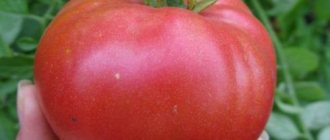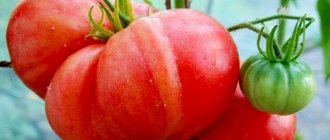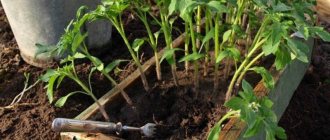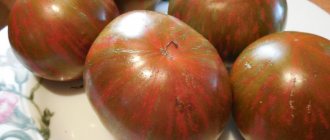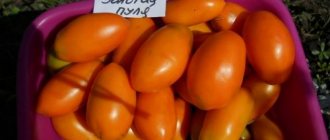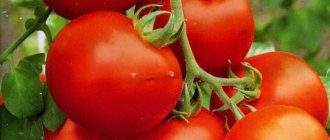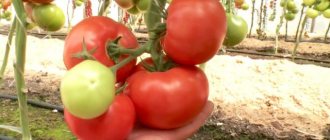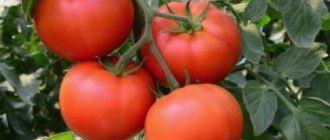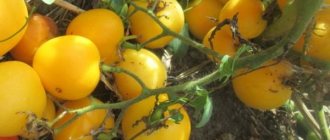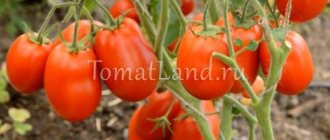Verlioka plus f1 is an updated version of the popular garden favorite, the Verlioka f1 tomato, which was bred by the Gavrish agricultural company back in 1990. The only difference between the hybrids was the size of the fruits. In the “plus” variety they are almost twice as large as in their predecessor.
| Height | Landing location | Ripening time | Fruit color | Fruit size | Origin | Fruit shape |
| Medium height | Greenhouse | Early ripening | Reds | Average | Hybrid | Round |
Description
The variety is determinate, with a bush height of up to 1.8 m. It requires the formation of a trunk into several stems and tying. Starting from sheet 8, brushes are formed. Each of them produces up to 10 tomatoes. The trunk is abundantly covered with large dark green leaves.
The variety is high-yielding. From 1 m2 you can collect up to 9 kg of fruit. Considered mid-season. The growing season lasts 105 days. Tomatoes are often grown in open ground. But they feel best under film or in a greenhouse.
Description and characteristics of the variety
Bush of determinate type, height 1.3-1.8 meters. Despite its early ripeness, the hybrid is recommended for cultivation in seasonal greenhouses and greenhouses. From germination to the first harvest you will have to wait 100-105 days. Tomato stems are significantly elongated, internodes are medium. The leaf is long, dark green in color, the leaf blades are sparsely spaced, their shape is similar to potato tops.
When they first met tomatoes, Europe perceived them as ornamental plants. At that time, tomato bushes could be seen in royal greenhouses and collections of noble people.
Inflorescences are of a simple type, formed through two leaves. Each brush forms from 5 to 7 ovaries. The lower fruits may be slightly larger than the upper ones, but on average the tomatoes are equal in size and shape. Verlioka plus f1 tomatoes are red, quite large - 120-140 grams each, round, even in shape, slightly ribbed at the top. The internal structure is four small chambers with seeds, the flesh is dense, pinkish-red.
Features of cultivation
Before planting, seeds are disinfected and soaked overnight in a growth stimulator. Store soil can also be treated with a disinfectant solution. The soil brought from the garden must be calcined in the oven and filled with a warm manganese solution.
The seeds are placed in compacted soil to a depth of 2–2.5 cm. Watered, covered with film and kept warm. In a few days the first shoots should appear. As soon as this happens, the seedlings are freed from the film and transferred to a well-lit place. Protect from drafts and water through a strainer.
When 2 leaves appear on the stem, pick and first fertilize. A week before planting in open ground, seedlings begin to harden. Young bushes can be taken to the dacha when they grow to 20–25 cm. The first flower cluster and 6–8 leaves appear.
Growing tomatoes
Agricultural technology and care for hybrid tomatoes "Verlioka Plus f1" are no different from the usual method of growing tall tomatoes. These tomatoes are grown in seedlings; in warmer regions, they are sown directly in the garden bed.
The tomato is excellent for growing in greenhouse conditions and under film cover.
How to prepare seeds?
Before sowing tomato seeds for seedlings, they need to be placed in a jar with a manganese solution. Before dissolving manganese in it, water must be heated to 25-30 degrees. The color of the solution should be light pink.
Seeds from the author Blagovest, Verlioka plus, Evpator, Rosamarin, Sicilian pepper:
After a few hours, the seed that has floated to the surface must be thrown away. Only those grains that have sunk to the bottom of the jar are suitable for sowing.
Sowing seed material
Seed material is sown for seedlings in a seed box filled with soil specially prepared for tomatoes. Soil for seedlings is prepared in advance. For this purpose, soil from the garden bed, bog peat and leaf humus are mixed in equal proportions.
Ready-made soil can be purchased in specialized stores. If a gardener plans to grow tomatoes on his personal plot in an open garden bed, then the seeds should be sown for seedlings at the end of February or the beginning of March.
Sowing is carried out according to the following plan:
- The seeds are immersed in the soil to a depth of 1-1.5 cm. Then the soil in the box is moistened with heated water from a spray bottle.
- After this, the seed box is covered with plastic film. As soon as the first shoots appear, the film must be removed.
- The room in which the boxes with seedlings are located should be well lit.
For seed germination, you need to ensure a temperature of at least 25 degrees.
Watering the seedlings is carried out every other day or as the soil dries. You can water tender sprouts only with a spray bottle.
Rules for planting seedlings
Seedlings should be well watered several hours before planting in the ground or greenhouse. A few days before planting, the bed is treated with a manganese solution and sprinkled with chemicals whose action is aimed at destroying harmful insects.
IMPORTANT: After 2-3 well-developed leaves appear on each plant, young tomatoes need to be transplanted into peat cups or any other suitable container.
After the required amount of protective agents has been added to the soil, the soil should be filled with water and fertilizers should be added. Humus and manure are added to the ground in the fall, after which the area is carefully dug up.
Transplantation into open ground
Before planting, prepare the soil. Remove all weeds, loosen well and dig deep (up to 13 cm) holes. They are well watered with warm water and fertilized. Bushes are planted at intervals of 70 x 50 cm.
Tomatoes planted in open ground are protected from the bright sun. When the seedlings become stronger, the film can be removed. Bushes in a greenhouse will require frequent ventilation. They can get sick from excess moisture in the soil and air. Leaves, fruits and stems will begin to rot.
Plants are watered only with warm water. They are fed with both mineral and organic fertilizers. The first time this is done 2 weeks after planting the seedlings on a summer cottage. Then, every 10 days until flowering begins. After the ovaries appear, root feeding is carried out 2-3 times with mullein or bird droppings.
Advantages and disadvantages
Pros:
- The tomato shows excellent yield when formed into 2-3 branches.
- Tolerates slight shade.
- It produces a moderate number of shoots, which makes it possible to use the growing method with the transfer of the growing point.
- A high percentage of ovaries are obtained even with minimal care.
- Resistant to various nightshade diseases, especially late blight.
- Tomatoes can be used in any preparation, eaten fresh, or made into whole fruit rolls.
- Fruits picked from the branches in a state of technical ripeness ripen well at home.
Minuses:
- Loves rich, light soils with a slight acidity of 6-6.5%.
- To get a good harvest, a gardener must be able to form tomato bushes.
- The fruits are not stale, they can be transported, but they are not suitable for long-term storage.
Photo of tomato Verlioka F1
Verlioka tomato variety, description, characteristics and reviews, as well as cultivation features
For those who want to get a good tomato harvest, it is important not only to grow their plants correctly. The key to success is choosing the right variety. The Verlioka F1 variety has proven itself well among gardeners, as it is undemanding and has high yields with good care.
Origin and description of the Verlioka F1 tomato
Verlioka F1 is a first generation hybrid bred by Russian specialists. The variety was created by the Gavrish enterprise; it is not intended for cultivation in open ground. Tomatoes of this variety should be planted only in glassed greenhouses or under film cover. Nevertheless, it is quite successfully grown in garden beds, especially in warm regions.
Main characteristics
Verlioka is one of those varieties that are particularly productive. One bush can produce up to 5 kg of tomatoes. Moreover, this statement is true when grown both in open ground and in a greenhouse. A distinctive feature of tomatoes of this variety is the small amount of foliage. The bushes can reach one and a half meters in height. There are up to 5–6 fruits on one hand.
Up to 5–6 fruits can ripen on one Verlioki branch
Verlioka tomatoes can also be harvested in the technical ripeness phase: they ripen quite successfully indoors at room temperature. In addition, these tomatoes are very tasty and are good to use in homemade preparations. And when grown, the variety is quite resistant to temperature changes.
The fruits are round in shape, their weight is 80–100 g, they are glossy, juicy and dense, bright red in color, and have a rich sweetish taste. In addition, tomatoes of this variety are high in sugars, amino acids and beta-carotene. The advantage of these tomatoes is that they will not crack when it rains, and they can be stored for quite a long time.
Verlioka tomatoes are fleshy and dense, with a sweetish taste.
Since there are few leaves on the plant, during the formation of fruits it seems that the entire bush is strewn with tomatoes. They seem to hang down and cover the foliage.
This variety is rightfully considered universal. Verlioka is well suited not only for salads and sauces, it is also suitable for preparing soups and main courses, excellent tomato juice. Stuffed or pickled tomatoes will be very tasty. And the preparation will look very appetizing due to the small size of the fruit.
A pleasant feature of the variety is its unpretentiousness. Verlioca F1 is resistant to diseases that affect many nightshades, such as tobacco mosaic virus or cladosporiosis. Tomatoes tolerate unfavorable weather conditions well: this tomato will react quite calmly to a lack of sunlight and high humidity.
However, with all the advantages, Verlioka also has a number of disadvantages:
- the variety is very sensitive to fertilizing and soil nutrition;
- During growth, the bush must be tied up and shaped.
Planting and growing
This tomato should be grown from seedlings. This is how you can get the maximum effect in terms of yield. Before planting, the seeds must be disinfected in potassium permanganate, and then soaked in a growth stimulator for half a day.
Seeds are planted for seedlings in March. They should be planted to a depth of 2 cm, and after sprouts appear, they should be placed in a sunny place.
Seedlings are planted in the ground in the last ten days of May, but in the southern regions it can be done in April.
Before planting, tomato seeds must be disinfected in potassium permanganate.
The soil for planting tomatoes must first be prepared. Moreover, it is best to take care of this in the fall: you should dig up the ground and add manure or compost. And in the spring you should not apply manure, as this often causes a lush growth of vegetative mass, which shades and thickens the bush.
It is best to plant Verlioka in the ground after carrots, zucchini, cabbage or cucumbers. But its relatives - the nightshade family - will be bad predecessors.
Light soil with a neutral or slightly acidic reaction is perfect for this variety. If acidity is high, the soil should be limed.
Greenhouse soil should consist of ordinary soil and a soil mixture (to prepare it, you need to mix peat, humus, sawdust and mullein in a ratio of 3: 1: 0.5: 0.5).
After planting in a permanent place, Verlioka quickly takes root and grows. The planting density should be no more than 7–8 bushes per square meter.
Features of caring for Verlioka
When growing tomatoes, it is important to constantly monitor the bushes and remove excess side shoots. The pinching procedure is necessary in order for a single stem to form. The first time it should be done when the length of the shoots reaches 5–7 cm.
To properly form a bush, you need to perform pinching - remove excess branches
During the growing process, you need to monitor the plant. When the fourth inflorescence appears, the stem will need to be pinched - this will help increase the yield.
Verlioka tomatoes need to be watered abundantly, but infrequently. One bush requires about 5 liters of water. For irrigation you need to use warm water. In the future, a drip irrigation system will work well.
As the bush grows, it must be constantly fed. For this purpose, mineral fertilizers are used. It is best to fertilize Verlioka twice a month. Before the bush blooms, nitrogen-containing fertilizers are useful; after the formation of ovaries, potassium and phosphorus fertilizers are useful. Mineral fertilizing can be alternated with organic matter: an aqueous solution of mullein or bird droppings.
Diseases and pests
Despite the fact that this hybrid is resistant to major diseases: late blight, verticillium, fusarium, mosaic, it is still necessary to take preventive measures. It is recommended to treat the soil with a solution of potassium permanganate (2–3 g/10 l of water) before planting.
Treatment with a solution of potassium permanganate disinfects the soil before planting
In addition, you can prevent the occurrence of diseases by frequently loosening the soil and removing weeds. The bushes must be carefully inspected, and if pests are detected, the plant must be treated with insecticides.
Reviews from gardeners
Every year we experiment with tomatoes. There are so many new names, varieties, hybrids! But for 10–12 years now every year I have been planting the Verlioka hybrid. Well, I like him. Early, sweet, productive, resistant to all sorts of problems.
The skin is thick and the fruits are small - but this is even good for canning.
Source: https://yagodka.club/ovoshhi/paslenovye/tomaty/verlioka-tomat-otzyivyi.html
